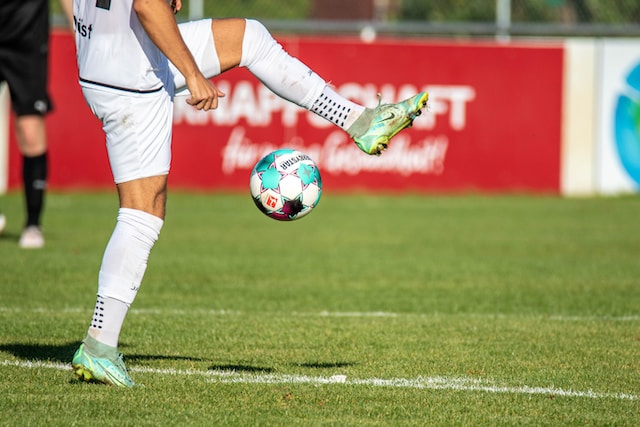Table of Contents
- What is a deep lying forward?
- What are the best attributes for a deep lying forward in soccer?
- Deep lying forward vs false nine
- Examples of deep lying forwards
- Why play with a deep lying forward?
- Is a deep lying forward the same as a trequartista?
- Recap: The deep lying forward in soccer
There are several ways to deploy a central forward on the soccer field, and utilizing a deep lying forward is one of them. Here, I explain everything you need to know about a deep lying forward in soccer and run through some of the key aspects of this role, should you decide to use it in your formation.
What is a deep lying forward?
A deep lying forward in soccer is responsible for linking the midfield with the attack. Rather than running in behind the defensive line, the deep-lying forward drops into pockets of space to hold up the ball and bring their teammates into the attack.
When deployed effectively, a deep lying forward can have a hugely positive impact on the way that a game is played and is a real asset to a team’s attack. Read on to find out more about a deep-lying forward in soccer and how this position is deployed.
What are the best attributes for a deep lying forward in soccer?
For a deep lying forward to be effective, they need to have the following attributes:
- Passing: Perhaps the most important attribute for a deep lying forward is passing. They are responsible for linking the play and passing the ball to different areas of the field while building attacks.
- Vision: This goes hand-in-hand with passing – it’s helpful if a deep lying forward has the vision to see runners and to pick out passes that pose an attacking threat to the opposition.
- Finishing: Fundamentally, a deep lying forward is your team’s biggest goal threat, so they need to be talented finishers! If they can’t find the target, they’re unlikely to help you score goals.
- Positioning: While poachers in soccer tend to play on the last line of defense, deep lying forwards need to drop back into midfield to link the play. This means that their positioning is key, as they need to take up smart positions to help your team build attacks.
Deep lying forward vs false nine

A false nine and a deep lying forward take up very similar positions on the soccer pitch and the roles are fundamentally the same.
The reason for the description of this position as “false” comes from the fact that a traditional number nine leads the line, while a deep lying forward (false nine) drops back into a deeper position.
This makes them much more difficult to mark than traditional number nines as defenders are torn between holding their defensive shape and dropping into midfield to follow the false nine.
One difference between the two roles is that a false nine will typically drop deeper than a deep-lying forward. Still, some coaches use the two roles interchangeably and there’s not a great deal of difference between them.
Examples of deep lying forwards
There are several attacking players over the years who have perfected the role of the deep lying forward. In the modern game, Harry Kane is a brilliant example of this, dropping into the midfield to link up play, helping his teammates get the most out of the pace of his partner in crime, Son Heung-min.
Under Pep Guardiola’s stewardship, Lionel Messi starred as Barcelona’s deep lying forward, though his role was so dynamic that he played practically anywhere he liked!
Another good example of a deep lying forward is Bayern Munich’s Thomas Muller. What I like about Muller is that he never comes across as an exceptional soccer player. He makes the game look so easy and is positionally one of the greatest forwards of his generation.
His work rate is also second-to-none and he is so highly regarded by Bayern Munich fans because of his never-say-die attitude.
Why play with a deep lying forward?
It’s a good idea to play with a deep lying forward if you don’t want your centre forward to become isolated. Sometimes, when you play with a target man or an advanced forward, the gap between the central point of your midfield and the central point of your attack can be too big.
As a result, you might then struggle with your link up play and the fact that your forward is isolated will make it so much more difficult for your team to pose significant questions to your opposition in the danger zone.
However, as is the case with all positions on the soccer field, make sure that the player that you deploy as a deep lying forward has the necessary attributes to play the role well, as introduced above.
Is a deep lying forward the same as a trequartista?
No, a deep lying forward is not the same as a trequartista. The main difference is that a trequartista is a midfield role, while the deep lying forward is an attacking role.
As a result, the trequartista will always take up a much deeper position than the deep lying forward. It’s helpful to think of the trequartista as a conventional number ten and the deep lying forward as a false nine.
Crucially, it’s not a good idea to employ a trequartista and a deep lying forward. This is because they will end up taking up similar positions on the soccer field and may end up nullifying one another’s threat!
Recap: The deep lying forward in soccer
The deep lying forward in soccer can be a key role and is a good option if you want to successfully link the center of your midfield to the center of your attack.
For inspiration, look at the role that Harry Kane plays for Tottenham Hotspur. He has mastered the role of the deep lying forward in soccer, as he has proven with the sheer number of goals he has scored.

